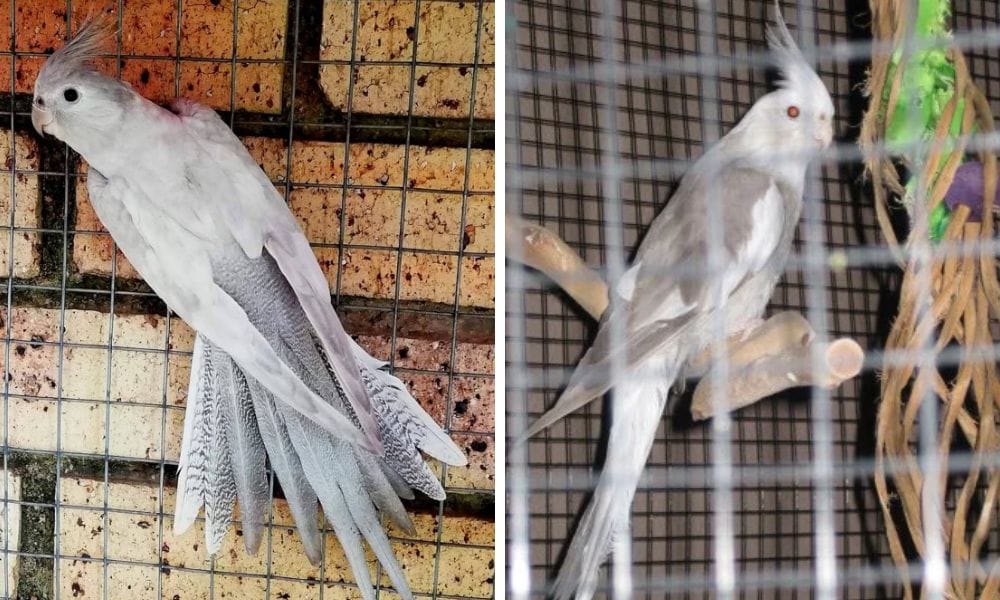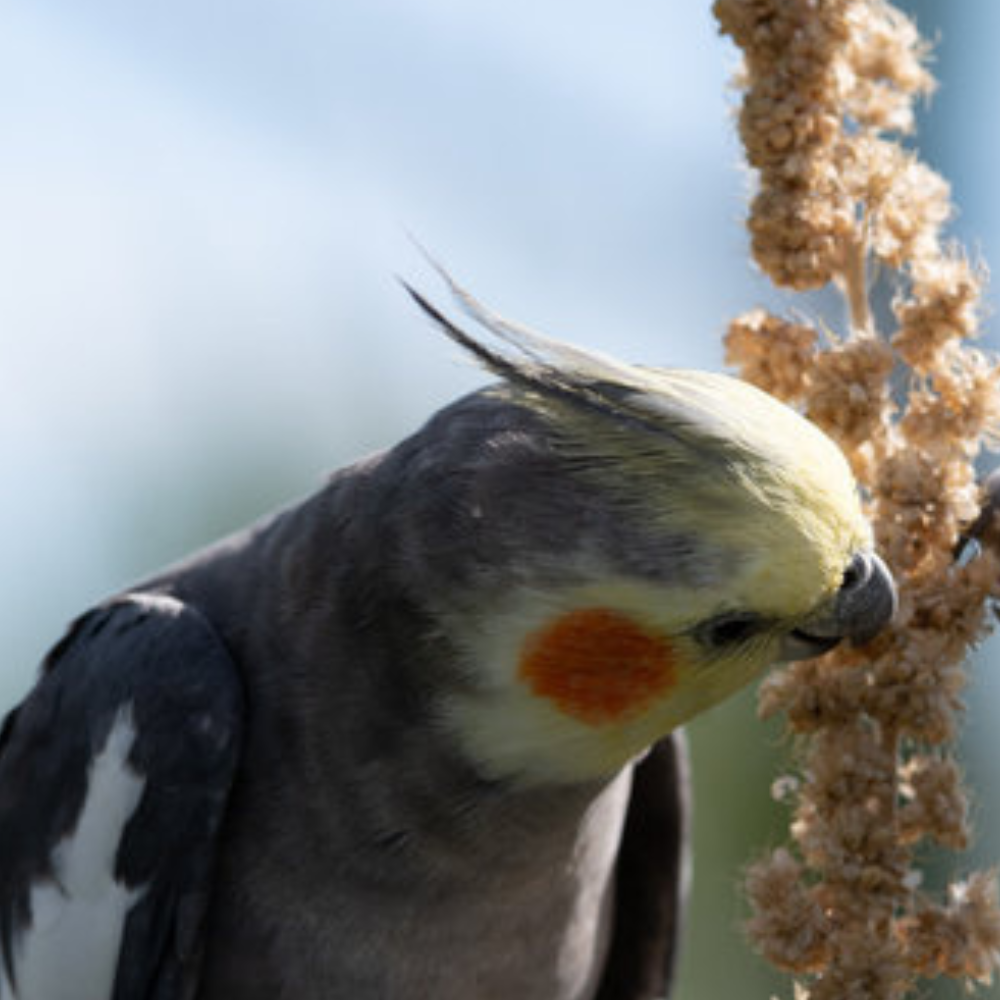Unveiling the Mystique of the Ashenfallow Cockatiel
Discover enigma of the avian world - the Ashenfallow Cockatiel. From its unique coloration to its endearing personality, this bird has captured the hearts of thousands around the world.

Key Takeaways:
- Discover the unique characteristics and care requirements of the ashenfallow cockatiel, a rare cockatiel mutation.
- Learn about the differences between male and female cockatiels, including visual sexing cues.
- Understand the importance of consulting an avian veterinarian for the health and well-being of your ashenfallow cockatiel.
Cockatiels are one of the most cherished pet birds in the avian world, known for their charming personalities and striking plumage. Among the various color mutations, the ashenfallow cockatiel stands out as a rare and captivating variety. This article delves into the world of ashenfallow cockatiels, exploring their unique features, care needs, and how they fit into the broader spectrum of cockatiel colors.
The Ashenfallow Cockatiel: A Rare Beauty
The ashenfallow cockatiel is a genuine member of the cockatoo family's biological features, boasting a distinctive appearance that sets it apart from other parrots. With grey feathers that exhibit a light grey, almost silver hue, these active birds are a sight to behold. Their long tail feathers and the round orange area on their cheek patches add to their allure, making them a prized possession for bird enthusiasts.
Understanding Cockatiel Mutations
Cockatiel mutations can be complex, with variations like the lutino cockatiel, cinnamon cockatiels, and the white-faced cockatiel. The ashen fallow cockatiel is part of this diverse group, inheriting its unique coloration from a combination of genetic traits. These mutations affect the cockatiel's plumage, resulting in a spectrum of colors that range from the normal grey to the dramatic albino cockatiels and blue cockatiels. For the clarity Ashen fallow= Pale fallow = Recessive Silver. They should all be called Ashen fallow, as you can see how confusing it can get with three different names for one and the same colour mutation. The name pale fallow is common now in Europe. It's even in the show standards, so it won't be easy to change.
Male vs. Female: Visual Sexing in Cockatiels
Sexing cockatiels can be a challenge, but certain visual cues can help distinguish male cockatiels from female cockatiels. Adult males typically display more vibrant colors and may have more pronounced markings on their wings and body. In contrast, female pearl cockatiel and other females often have more subdued hues and may exhibit barring on the underside of their tail feathers.
The Unique Palette of the Ashenfallow Cockatiel
The ashenfallow cockatiel's color palette is a testament to the diversity of rare cockatiel mutations. Their grey feathers are tinged with a recessive silver, creating a mesmerizing effect. Unlike the dominant silver mutation, the ashenfallow's coloration is more muted, with a light grey base that can vary in intensity among individuals.
Health Considerations for Ashenfallow Cockatiels
Like all cockatiel parrots, ashenfallow cockatiels require attentive care to prevent health issues such as respiratory diseases. Regular check-ups with an avian veterinarian are crucial to ensure that these pet birds remain in a neutral or relaxed state of health. A balanced diet, clean cage, and ample exercise are also key to maintaining their well-being.
The Social Dynamics of Cockatiels
Cockatiels are social creatures, and the ashenfallow variety is no exception. They thrive in environments where they can interact with their human caretakers or other parrots. Understanding the cockatiel's social needs is essential for fostering a happy and healthy bird.
The Importance of a Suitable Habitat
Providing a suitable habitat for your ashenfallow cockatiel is vital. The cage should be spacious enough to accommodate their wingspan and allow for free movement. Additionally, the cage should be equipped with perches, toys, and nesting areas to mimic their natural environment and stimulate their active minds.
The Evolutionary Journey of Cockatiel Varieties
The cockatiel, a cherished member of the parrot family, has undergone a fascinating evolutionary journey, resulting in a spectrum of colors and patterns that delight avian enthusiasts. The grey cockatiel, often referred to as the 'wild type', is the ancestral form from which all other mutations have emerged. This foundational plumage showcases the cockatoo family's biological features, such as the iconic yellow head and the dramatic 'cheek patches' that are a hallmark of these birds. Over generations, selective breeding has amplified these traits, giving rise to stunning variations like the cinnamon cockatiel and the white-faced cockatiel, each with their unique charm.
In the wild, the cockatiel's plumage serves a practical purpose, with the grey tones blending seamlessly into the Australian landscape, providing camouflage from predators. The male and female cockatiel can often be distinguished by subtle differences in coloration; for instance, the male typically exhibits a more vibrant yellow head and clearer white spots on the outer edges of the primary wing feathers. In contrast, the hen's markings are generally more muted, and her facial coloring less pronounced. These visual cues are not just for human appreciation but play a crucial role in the birds' social signaling and mating rituals.

The Ashenfallow Cockatiel: The Only Cockatoo Species with Such Distinctive Markings
The Ashenfallow cockatiel stands out as the only cockatoo species to exhibit such a unique combination of color mutations. This distinction places it in a league of its own within the cockatoo family's biological features. The ashen hues blended with the traditional cockatiel's plumage create a mesmerizing effect that is both rare and sought after by avian enthusiasts. The subtle gradations of color that characterize the Ashenfallow variety are a testament to the complexity of genetic inheritance and the beauty that can arise from it.
Unlike the more common white-faced cockatiel, the Ashenfallow's plumage does not display the stark contrasts of pure white and dark grey. Instead, its feathers carry a softer, more diluted coloration that gives it an almost ethereal appearance. This muted palette is particularly noticeable in the male cockatiel, where the typical vibrant cheek patches are replaced with a gentler shade, further distinguishing the males from their female counterparts and adding to the allure of this unique mutation.
The Beak and Feather Dynamics of the Ashenfallow Cockatiel
The beak of the Ashenfallow cockatiel is another feature that captivates the attention of bird lovers. While it shares the same robust and curved shape characteristic of the cockatoo family, the beak's color can sometimes reflect the bird's overall muted tones, offering a harmonious look that complements its special plumage. This synergy between beak and feather is a subtle yet fascinating aspect of the Ashenfallow's appearance, contributing to its overall mystique and charm.
In comparison to parakeets and other small parrots, the Ashenfallow cockatiel's feathers have a unique texture and structure that are indicative of its cockatoo lineage. The feathers are designed to support the bird's acrobatic maneuvers and social displays, which are integral parts of cockatiel behavior. Observing an Ashenfallow cockatiel in full flourish, with its crest raised and wings outstretched, is a sight that underscores the dynamic interplay between form and function in these captivating birds.
Cockatiel Mutations and Their Distinctive Features
Among the plethora of cockatiel mutations, the blue cockatiel stands out as a particularly intriguing variety. Although not as commonly found as other mutations, the blue cockatiel's plumage captivates with a gently oblique shift from the traditional color palette, introducing a serene hue that is both unexpected and enchanting. This mutation is a testament to the genetic diversity within the cockatoo species, showcasing how a single gene can dramatically alter the bird's appearance. Similarly, the cinnamon cockatiel, with its warm, brownish-grey feathers, offers a softer alternative to the standard grey.
The white-faced cockatiel takes the departure from the wild type even further, eliminating the yellow and orange pigments entirely to reveal a striking, monochromatic visage. In these birds, both sexes feature the dramatically vertical and flattened close tail feathers that are biologically classified as a key characteristic of the species. The absence of the typical cheek patch coloration in the white-faced variety underscores the remarkable adaptability of the cockatiel's plumage. These mutations not only provide a visual feast for bird lovers but also contribute valuable insights into the genetic mechanisms that govern avian coloration.
Breeding Ashenfallow Cockatiels
Breeding ashenfallow cockatiels can be a rewarding experience, but it requires knowledge of genetics and a commitment to responsible practices. Ensuring that both male and female cockatiels are healthy and compatible is the first step in a successful breeding program.
The Role of Genetics in Cockatiel Colors
Genetics play a pivotal role in the development of cockatiel colors, including the ashenfallow mutation. Understanding the inheritance patterns of these mutations can help breeders predict the outcome of mating pairs and preserve the unique characteristics of the ashenfallow cockatiel.
Diet and Nutrition for Optimal Health
A balanced diet is crucial for the health of ashenfallow cockatiels. A mix of seeds, pellets, fresh fruits, and vegetables should be provided to ensure they receive all the necessary nutrients. Avoiding foods that are toxic to birds, such as avocado and chocolate, is equally important. If you are looking for best cockatiel foods you can find it in our blog below.

Recognizing and Preventing Common Ailments
Cockatiels, including the ashenfallow variety, are susceptible to common ailments such as respiratory diseases. Recognizing the signs of illness early and taking preventative measures, such as maintaining a clean living environment, can help keep your bird healthy.
The Joy of Cockatiel Companionship
Owning an ashenfallow cockatiel can bring immense joy and companionship to your life. Their playful nature and ability to bond with their owners make them delightful pets. With proper care and attention, these rare cockatiel mutations can become beloved members of the family.
Training and Bonding with Your Ashenfallow Cockatiel
Training and bonding with your ashenfallow cockatiel can enhance your relationship and provide mental stimulation for your bird. Simple tricks, regular handling, and positive reinforcement can go a long way in building trust and affection.
The Significance of Regular Veterinary Care
Regular visits to an avian veterinarian are essential for the health of your ashenfallow cockatiel. These specialists can provide tailored advice and care, ensuring that your bird remains in top condition throughout its life.
The Ashenfallow Cockatiel in Aviculture
The ashenfallow cockatiel is a testament to the beauty and diversity of aviculture. As a rare mutation, it represents the potential for continued discovery and appreciation of the many varieties of cockatiels and other pet birds.
Summary
The ashenfallow cockatiel is a rare and enchanting member of the cockatiel family, boasting unique grey feathers with a light grey or silver tint. These birds require specific care, including a balanced diet, a spacious cage, and regular veterinary check-ups. Understanding the differences between male and female cockatiels, as well as the genetic factors that contribute to their color mutations, is essential for any potential owner or breeder. With their sociable nature and captivating appearance, ashenfallow cockatiels are a joy to have as companions.
FAQ Section
Q: How can I tell if my cockatiel is an ashenfallow? A: Ashenfallow cockatiels have a distinctive light grey or silver coloration with grey feathers and long tail feathers. They may also have red eyes, which is a common trait among fallow cockatiels. If you're unsure, consulting with an avian veterinarian or a breeder specializing in cockatiel mutations can provide confirmation.
Q: Are ashenfallow cockatiels more prone to health issues than other cockatiel mutations? A: Ashenfallow cockatiels do not inherently have more health issues than other cockatiel mutations. However, all cockatiels can be prone to certain health problems, so it's important to provide proper care, nutrition, and regular veterinary check-ups to maintain their health.
Q: Can ashenfallow cockatiels be trained and tamed like other cockatiels? A: Yes, ashenfallow cockatiels can be trained and tamed just like any other cockatiel. They are intelligent and social birds that respond well to positive reinforcement and consistent interaction with their owners.

